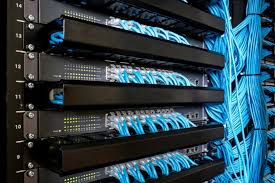Structured cabling is the backbone of any modern network infrastructure. It provides a standardized and organized approach to connecting devices within a building or campus, ensuring flexibility, scalability, and high performance. This white paper explores the key aspects of structured cabling, its benefits, and its critical role in today's interconnected world.
Structured Cabling: A Foundation for Modern Networks
1. Introduction
Structured cabling is the backbone of any modern network infrastructure. It provides a standardized and organized approach to connecting devices within a building or campus, ensuring flexibility, scalability, and high performance. This white paper explores the key aspects of structured cabling, its benefits, and its critical role in today's interconnected world.
2. Core Components of Structured Cabling
- Horizontal Cabling: Connects workstations, servers, and other devices to the telecommunications room (TR) or intermediate distribution frame (IDF).
- Backbone Cabling: Connects the TR/IDF to the main distribution frame (MDF) or other backbone components.
- Work Area Cabling: Connects devices within a work area (e.g., workstations, peripherals) to the horizontal cabling.
- Telecommunications Room (TR): A central point for the termination of horizontal cabling.
- Main Distribution Frame (MDF): The central point for the termination of backbone cabling and the distribution of services to various parts of the building.
- Patch Panels: Used to connect cables to other cables or devices, allowing for easy reconfiguration and maintenance.
- Cabling Media: Primarily copper cables (e.g., Cat5e, Cat6, Cat6a) and fiber optic cables.
3. Benefits of Structured Cabling
- Flexibility and Scalability: Easily accommodate changes in network requirements, such as adding new devices or relocating workstations.
- Improved Performance: Ensures high-speed data transmission, low signal loss, and minimal interference.
- Enhanced Reliability: Reduces the risk of network failures and downtime.
- Cost-Effectiveness: Reduces long-term costs by simplifying maintenance, upgrades, and future expansions.
- Improved Aesthetics: Well-designed and installed cabling systems can enhance the overall appearance of a building.
- Future-Proofing: Supports the integration of new technologies and applications, such as high-definition video, Voice over IP (VoIP), and high-speed data transfer.
4. Standards and Best Practices
- Industry Standards: Adherence to industry standards such as ANSI/TIA/EIA 568 ensures compatibility and interoperability between different components and systems.
- Proper Installation: Proper installation practices are critical to ensure optimal performance and longevity of the cabling system. This includes proper cable termination, bending radius adherence, and grounding techniques.
- Regular Maintenance: Regular maintenance, including testing and certification, is essential to ensure the continued performance and reliability of the cabling system.
5. Use Cases
- Office Buildings: Connecting workstations, servers, and other devices in office environments.
- Data Centers: Providing high-speed connectivity for servers, storage devices, and network infrastructure.
- Educational Institutions: Connecting classrooms, laboratories, and administrative offices.
- Healthcare Facilities: Supporting critical applications such as electronic health records (EHRs) and medical imaging.
- Industrial Environments: Connecting industrial control systems, automation equipment, and other critical infrastructure.
6. Conclusion
Structured cabling is a critical foundation for any modern network infrastructure. By adhering to industry standards and best practices, organizations can ensure a reliable, scalable, and cost-effective network that supports their current and future needs.
References:
- ANSI/TIA/EIA 568 Commercial Building Telecommunications Cabling Standard: [invalid URL removed]
- BICSI: https://www.ieee.org/ (Institute of Electrical and Electronics Engineers)
Disclaimer: This white paper provides a general overview of structured cabling. The specific requirements and implementations will vary depending on the individual application and environment.
This information is for general knowledge and informational purposes only.
